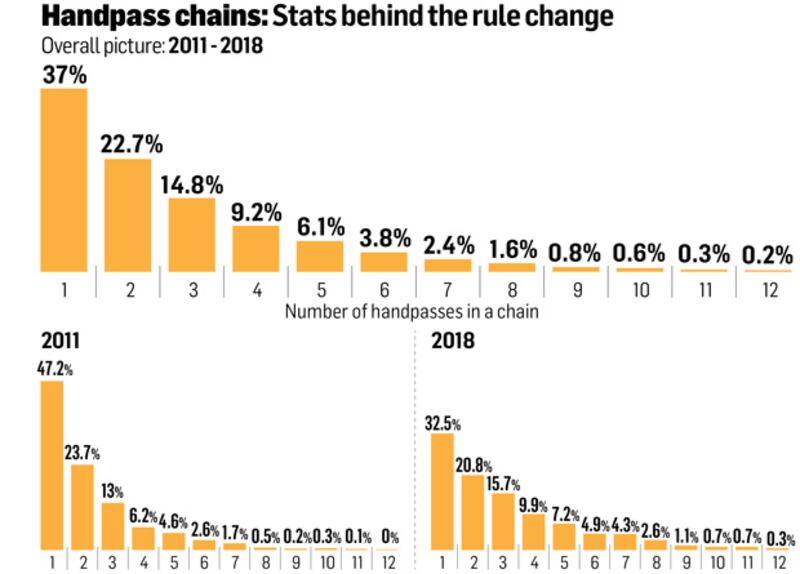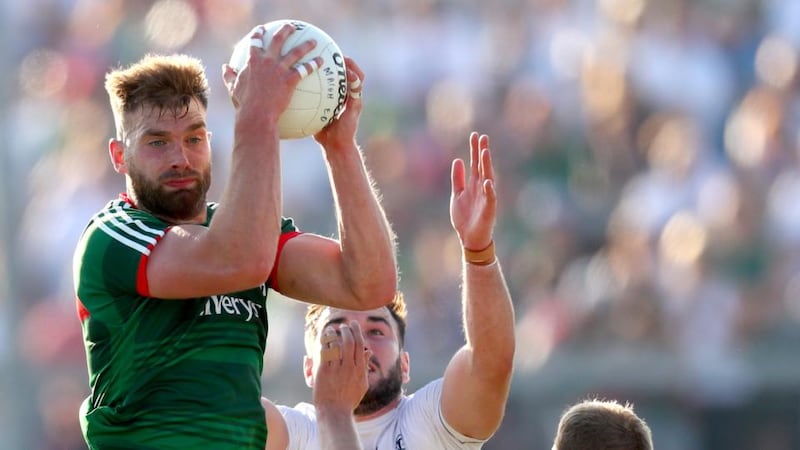“Do players get a say in these rules? Some absolute ridiculous decisions . . .why change the game based on one or two bad matches? The #GAA has lost it’s marbles with all these rule changes.” - Ben McKinless, Derry goalkeeper.
"It's embarrassing for some of that rules committee that they went to print. There's no logic to it at all. I don't know if they even played the game. It was embarrassing to even read it. But for them to sit down and waste time, and to let that go to print . . ." - Darren Hughes, Monaghan footballer.
Lads, lads, lads. Whatever happened to the old dictum of it being better to stay quiet and be thought a fool than to open your mouth and remove all doubt? The proposed rule changes in football have divided opinion, as of course they should. But it surely ought not be beyond the wit of man to take a dim view of them while at the same time allowing that a huge amount of serious work went into their drafting.
If not, anyone with misgivings should sit down with Rob Carroll. He won't try to change anyone's mind - he is neither for nor against the changes to any great extent. But an hour in his company is enlightening, most especially when it comes to the data underpinning the work of the Standing Committee on Playing Rules in Croke Park.
Carroll goes variously by GaelicStats and Thevideoanlayst online and has worked with several county teams over the past decade. The 35-year-old has been the stats man for the International Rules team under Paul Earley as well. He talks in the calm, undramatic manner you would expect from someone of his background and has no bone to pick with anyone, regardless of their outrage.
“No, I have no vested interest here at all,” he says. “I didn’t come up with the rules, I was only in for a couple of meetings, I gave them data and some sample clips for the areas they were looking into. But no, I wasn’t there when they decided how to shape the rules or pick the number of handpasses to cut off at or anything like that. That’s not washing my hands of them but I don’t want to overplay my role either.”
Back in 2011, Carroll took a notion of doing statistical analysis of all televised matches in the football championship. Partly it was scratching an itch but partly it was to make himself more valuable to teams looking to bring new stats people into their backroom teams.
“I worked with teams here and there and they were very good at having and analysing their own info but not so much with opposition. They might take a game here and there but there was no sense of, ‘is this what they always do? Or ‘what were they like last year and how have they evolved?’ And then when managers changed and backroom teams changed, all that info got dumped most of the time.
“So I just thought it would be a good thing to have at my disposal when I started working with a team, that I could show patterns and trends across the board. It’s not that many games. It’s not like the Premier League in soccer where they have 380 games in the course of a season. It’s 60 games at most really. So I thought it would make me more useful.”

So he began collecting numbers on pretty much anything that happened in a televised game. Every handpass, every footpass, every shot, every foul, every turnover. Anytime a player touched a ball, that was a recordable event. So far, he has built up a database covering 322 football matches over eight seasons of championship.
Back at the start, he got in touch with Pat Daly in Croke Park and asked had they any of this sort of data at their disposal. Daly said they didn't but they'd love to have it. Not with any great purpose in mind but you'd never know when it would become useful. And so, when the committee - of which Daly is a key member - set about coming up with rule changes earlier this year, they got Carroll in to give them a presentation.
“Something that has jumped out at me - and it probably is the driving force behind the proposed playing rule changes - the number of team possessions in a game has plummeted since 2011. If you take a possession as a goalkeeper kicks it out to a teammate and the teammate moves it on until there is either a shot or a foul or a turnover, in 2011 there was on average 130 of those in every game. Now, in 2018, that average is down to 97.
“You’ve gone from a sport where it was, to an extent, you-have-it-then-we’ll-have-it-then-you-have-it pattern to the game. What we have now is a situation whereby even though the games are longer because of the referees using proper added time, even though the ball is in play way longer and even though there are more shots and more scores, there are significantly fewer possessions in every game. So what that tells us is that the number of turnovers is way, way down.

“When a team has the ball, they hold onto it until they can have a shot. It means teams are down from around 65 possessions a game to around 45 - meanwhile the number of scores needed to win a game has gone up. You generally have to get 20 points to win now, out of 45 possessions. If that’s, say, 1-17, you need to score 18 times. You only score 50 per cent of your shots, give or take, so that’s 36 shots you need to take in a game. Therefore, you can’t turn the ball over more than eight-to-10 times in a game.”
As a result, the turnover stat has become one of the most focused-upon numbers in the game. A player who gives the ball away twice or three times in a half knows it long before the stats man sidles up to him at half-time. Possession is sacred, therefore the handpass is venerated.
“This is almost completely a possession game now. I think the committee - and I wouldn’t want to speak for them at all but this is my sense of it - their starting point is that the overwhelmingly possession-based game is something that they want to change. So you have to put in an element of risk-reward in order to incentivise that.
“I would imagine that’s what the new mark rule is designed for. At the moment, it’s just too risky to kick it in to the inside forward line because even if the forward catches it, he’s double-marked so what’s the reward? Players know themselves not to attempt it because the over-arching need is to prevent turnovers. This could balance that up a little. Managers now might have to go, ‘well, we won’t win all of the balls kicked in there but if we win two out of four, that’s two points on the board. That tilts the balance back a little.’

“Even in the noughties, teams kicked so much more because essentially they knew they were going to get it back. You could try that diagonal 40-yard ball into the full-forward line because you knew that if it didn’t come off, the other team would soon try it too, maybe even in the next possession. And you were getting up around 65-75 possessions a game. Over the course of this decade, teams have basically changed their mindset to one of, ‘we are going to keep this ball. We don’t know when we’re going to get it back so we’re making sure we keep you away from it for as long as possible.’”
The largest bank of data Carroll had for the committee concerned the handpass. Over the 322 games, he examined almost 100,000 handpasses, coming up with numbers on how often one handpass led to another and, crucially, how the average number of consecutive handpasses - or ‘handpass chains’ in the vernacular - has changed over the eight seasons.
In 2011, the longest handpass chain he recorded went through 14 pairs of hands before something else happened. In 2018, that number rose to 23. In a way, because those figures are outliers, they’re not massively useful to the conversation. But they obviously point to an overall trend.
For the committee, the more relevant numbers are over at the other side of the charts (above). In 2011, 83 per cent of handpass chains lasted no more than three consecutive handpasses. In 2018, that number has fallen to 68 per cent. In effect, what this means is that the number of handpass chains of four or more handpasses has doubled in eight seasons. Once the committee decided to curtail it, they had to settle on a cut-off point. Using Carroll’s numbers, they landed on three.
“Nobody knows what the limit should be. But if you take international Rules, the limit is six. If you look at the graph, making the limit six in Gaelic football would make almost no difference. You would only be dealing with chains that currently make up less than 10 per cent of moves in the game. So by picking three handpasses as the cut-off, you are targeting 32 per cent of handpass chains and eliminating them.
“Now, whether they turn into contestable kick-passes or not, only time will tell. I think as a general principle, what the committee were aiming for is to make the game a little bit more chaotic and a little bit more ‘what’s-going-to-happen-next?’ Rather than one team has it and moves patiently up the pitch and then the other team does the same when it’s their turn.”
The game evolves and shapeshifts all the time. On a lark - and not that it’s relevant in any way, shape or form - Carroll watched the 1965 football final once and found that the game was 13 minutes old before he counted the first handpass. Nobody, not even the most misty-eyed traditionalist, is looking for a return to those times. But there does appear to be a critical mass of opinion that feels it has tilted too much in the direction of keep-ball-for-all.
Plenty disagree, as they should and as they must. Be angry by all means, be outraged, knock yourself out. But don’t imagine this stuff happens on a whim, dreamed up on a Monday night for release on a Tuesday afternoon.
Whatever the rights and wrongs, the last charge that can be levelled is Darren Hughes’s one of there being no logic to the changes. And as for Ben McKinless and his “one or two bad games”, it’s probably best not to run that one past a man who sat through 322 matches and pored over the thick end of 100,000 handpasses.
“I was purely there to give them the numbers and what they did with them then was up to them,” says Carroll. “I’m just intrigued as much as anything to see how it plays out.”
On that, he’s far from alone.














